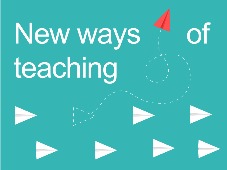How to ask and structure questions

In this monthly blog about new ways of teaching , educators talk about their innovative, creative and impactful teaching initiatives. From unusual teaching methods to new technologies - everything is covered. How did these ideas come about and what impact does it have on students?
This month, Martin Lenz, Professor of History of Philosophy at the Faculty of Philosophy about asking questions. A longer version of this blogpost was originally posted at Handling Ideas , a blog run by Martin himself.
We ask questions all the time. But do the questions we actually ask get down to the questions we want to ask? If you ask students whether they have questions about any given text, you’re often met with embarrassed silence. It’s hard to admit that you’re confused. Although asking questions is a crucial activity, how to do this is hardly ever explained. By teaching to structure and analyse questions, I attempt to achieve five things:
-
Countering embarrassment by suggesting that genuine questions require confusion;
-
Showing how confusion generates the motivation of a question by having students spell out what (passage) precisely causes confusion;
-
Showing that confusion is often the result of (frustrated) expectations as a reader;
-
Detailing how to analyse such expectations as hidden theoretical assumptions;
-
Having students estimate what possible answers might look like, e.g. by estimating how assumptions in the text differ from one’s own assumptions.

While stimulating active learning, most steps can be achieved without requiring new information, but rather by developing an understanding of how one’s confusion arises. Accordingly, students are encouraged to enter into a dialogue with their own hidden assumptions and with others, for instance, by articulating how their background assumptions might differ. It is designed to stimulate self-directed learning and exchange as well as benefitting from seeing diversity in assumptions. The technique of structured questions is an active learning device and was positively evaluated by students at my Faculty. I designed it to foster self-directed learning and interaction with texts and interlocutors. Being geared towards texts and discussions generally, it should be easily transferable to other disciplines.
How to get started?
In my courses I instruct students that the question should focus on a brief passage from a text or locution. It must comprise no more than 500 words and contain the following components:
-
Topic: say what the question is about (the passage or concepts that cause confusion)
-
Question: state the actual question
-
Motivation: give a brief explanation why the question arises (use your assumptions or frustrated expectations)
-
Answer: provide a brief anticipation of at least one possible answer (e.g. by guessing at the implicit assumptions in the text and how they might differ from yours).
What do I want to teach in designing this?
My initial goal was to offer a way of engaging with all kinds of difficult texts. When doing so I assumed that understanding (a text) can be a general aim of asking questions. I often think of questions as a means of making contact with the text or interlocutor. For a genuine question brings two aspects together: on the one hand, there is your question, on the other hand, there is that particular bit of the text that you don’t understand or would like to hear more about.
In order to enter into dialogue, readers or interlocutors need to learn to consider questions such as: Why exactly am I confused? Could it be that my own expectations about the text send me astray? What am I expecting? What is it that the text doesn’t give me? Arguably, readers need to understand their confusion to make genuine contact with the text. One’s own confusion needs to be understood. The good news is: this often can be achieved without acquiring new information. Instead, bringing together one’s own expectations or assumptions with those of the text (or those of other readers) initiates a meeting of minds.
Further Reading
-
Martin Lenz
More news
-
15 September 2025
Successful visit to the UG by Rector of Institut Teknologi Bandung
